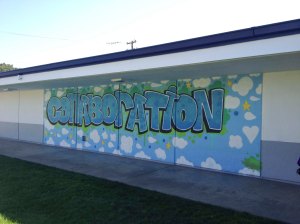Edcite’s Field Trip to Katherine Smith Elementary
At first, Katherine Smith Elementary seemed like it would be any other elementary school: tiny athletes played soccer on a field during recess and students smiled shyly at the visiting strangers during class transitions. Our visit turned out to be far from ordinary — the student learning and engagement is nothing short of amazing.

While our student ambassadors were wrapping up class, Lucy Helveston, K. Smith’s STEM specialist, gave us a brief overview of the school’s cornerstone: project-based learning (PBL). We were impressed with the amount of trust staff had in students’ ability to create and implement real solutions to real world problems. For example, K. Smith fifth graders combined their learning about early explorers with their knowledge of volume and density design and build cardboard boats they tested on an actual lake. The sixth graders designed and drew the campus garden beds to scale and, amidst the California water shortage, mapped out best placement for their water pipelines. Their next project? Working on a rain barrel to capture and reuse rainwater for their garden and designing a greenhouse for potted plants! Kindergarteners applied their learning about helpful and harmful garden invertebrates by creating clay models they would then exhibit in the upcoming Maker’s Fair.
Practical Applications
So how does one create this amazingly collaborative, innovative culture of learning that permeates Katherine Smith’s campus?

Part of the answer lies in the staff’s strong commitment to collaboration and culture. Two years ago, with Common Core looming on the horizon and a history of lower academic performance to overcome, Evergreen School District made a bold move allowing Katherine Smith Elementary’s administration to start afresh and adopt a project-based learning (PBL) curricula… and by adopt, we mean design! K. Smith’s teachers make use of planning days and afterschool time to collaborate on interdisciplinary projects. Assistant Principal Nanette Donahue describes how the teachers are excited about learning as well and willing to give and take critical feedback. They care a lot about reinforcing real world skills: collaboration, communication, creativity, and critical thinking. She explains their teachers value and maintain a “culture that excites” students to learn everyday.

Another key for implementing project-based learning is to make sure to ground each project with a driving question, a question that all students will be able to answer at the end of the project. Along the way to answering this driving question, students and teachers create a list of “Need to knows” — a series of smaller questions that help define the path for the project. Questioning of this sort engages students in meaningful exploration and learning. “It’s a deeper learning movement,” Principal Brengard explains.
Looking Forward to a Brighter Future
Our small team of educators and engineers left Katherine Smith Elementary inspired by the staff’s trust in the students’ ability to acquire the necessary skills to create a lasting impact in its community. Given the right balance of freedom and guidance, Katherine Smith students prove that they can design a water pump and pipeline system, build boats, pitch startup ventures, code video games, publish poetry, and even identify ways to reduce their carbon footprint–all through effective collaboration and communication! What more can we hope for in our young, future leaders?


Thanks for the great blog, Edcite. Looking forward to an innovative partnership.